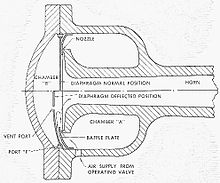The amplitude of a periodic variable is a measure of its change in a single period. The amplitude of a non-periodic signal is its magnitude compared with a reference value. There are various definitions of amplitude, which are all functions of the magnitude of the differences between the variable's extreme values. In older texts, the phase of a periodic function is sometimes called the amplitude.

A loudspeaker is an electroacoustic transducer that converts an electrical audio signal into a corresponding sound. A speaker system, also often simply referred to as a speaker or loudspeaker, comprises one or more such speaker drivers, an enclosure, and electrical connections possibly including a crossover network. The speaker driver can be viewed as a linear motor attached to a diaphragm which couples that motor's movement to motion of air, that is, sound. An audio signal, typically from a microphone, recording, or radio broadcast, is amplified electronically to a power level capable of driving that motor in order to reproduce the sound corresponding to the original unamplified electronic signal. This is thus the opposite function to the microphone; indeed the dynamic speaker driver, by far the most common type, is a linear motor in the same basic configuration as the dynamic microphone which uses such a motor in reverse, as a generator.

A microphone, colloquially called a mic, is a transducer that converts sound into an electrical signal. Microphones are used in many applications such as telephones, hearing aids, public address systems for concert halls and public events, motion picture production, live and recorded audio engineering, sound recording, two-way radios, megaphones, and radio and television broadcasting. They are also used in computers and other electronic devices, such as mobile phones, for recording sounds, speech recognition, VoIP, and other purposes, such as ultrasonic sensors or knock sensors.

The Chicago Blackhawks are a professional ice hockey team based in Chicago. The Blackhawks compete in the National Hockey League (NHL) as a member of the Central Division in the Western Conference and have won six Stanley Cup championships since their founding in 1926. They are one of the "Original Six" NHL teams, along with the Detroit Red Wings, Montreal Canadiens, Toronto Maple Leafs, Boston Bruins, and New York Rangers. Since 1995, the team has played their home games at the United Center, which they share with the National Basketball Association's Chicago Bulls; both teams previously played at the now-demolished Chicago Stadium.
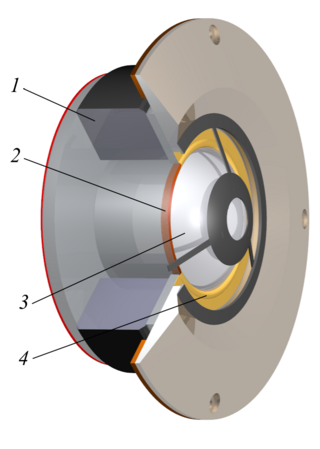
A tweeter or treble speaker is a special type of loudspeaker that is designed to produce high audio frequencies, typically deliver high frequencies up to 100 kHz. The name is derived from the high pitched sounds made by some birds (tweets), especially in contrast to the low woofs made by many dogs, after which low-frequency drivers are named (woofers).

In ice hockey, a goal is scored when the puck entirely crosses the goal line between the two goal posts and below the goal crossbar. A goal awards one point to the team attacking the goal scored upon, regardless of which team the player who actually deflected the puck into the goal belongs to. Typically, a player on the team attempting to score shoots the puck with their stick towards the goal net opening, and a player on the opposing team called a goaltender tries to block the shot to prevent a goal from being scored against their team.

The Chicago Stadium was an indoor arena in Chicago that opened in 1929, closed in 1994 and was demolished in 1995. It was the home of the National Hockey League's Chicago Blackhawks and the National Basketball Association's Chicago Bulls It was used for numerous other sporting events, opening with a championship boxing match in March 1929. The Stadium was built by Paddy Harmon, a promoter, who sank his entire fortune into the project, only to lose control to the Stadium shareholders, and leave his family nearly penniless a year later when he died. After exiting receivership in 1935, the Stadium was owned by the Norris and Wirtz families until its closure in 1994.

A siren is a loud noise-making device. Civil defense sirens are mounted in fixed locations and used to warn of natural disasters or attacks. Sirens are used on emergency service vehicles such as ambulances, police cars, and fire engines. There are two general types: mechanical and electronic.
In the field of acoustics, a diaphragm is a transducer intended to inter-convert mechanical vibrations to sounds, or vice versa. It is commonly constructed of a thin membrane or sheet of various materials, suspended at its edges. The varying air pressure of sound waves imparts mechanical vibrations to the diaphragm which can then be converted to some other type of signal; examples of this type of diaphragm are found in microphones and the human eardrum. Conversely a diaphragm vibrated by a source of energy beats against the air, creating sound waves. Examples of this type of diaphragm are loudspeaker cones and earphone diaphragms and are found in air horns.

A foghorn or fog signal is a device that uses sound to warn vehicles of navigational hazards such as rocky coastlines, or boats of the presence of other vessels, in foggy conditions. The term is most often used in relation to marine transport. When visual navigation aids such as lighthouses are obscured, foghorns provide an audible warning of rock outcrops, shoals, headlands, or other dangers to shipping.
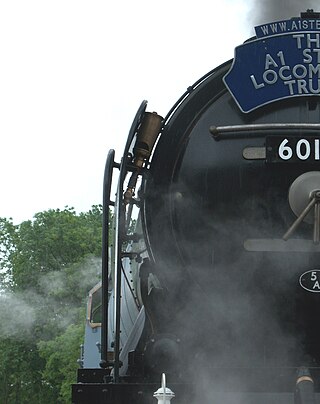
A train whistle or air whistle is an audible signaling device on a steam or gas locomotive, used to warn that the train is approaching, and to communicate with rail workers. Modern diesel and electric locomotives primarily use a powerful air horn instead of a whistle as an audible warning device. However, the word whistle continues to be used by railroaders in referring to such signaling practices as "whistling off".

A steam whistle is a device used to produce sound in the form of a whistle using live steam, which creates, projects, and amplifies its sound by acting as a vibrating system.

A crystal earpiece is a type of piezoelectric earphone, producing sound by using a piezoelectric crystal, a material that changes its shape when electricity is applied to it. It is usually designed to plug into the ear canal of the user.
An acoustic horn or waveguide is a tapered sound guide designed to provide an acoustic impedance match between a sound source and free air. This has the effect of maximizing the efficiency with which sound waves from the particular source are transferred to the air. Conversely, a horn can be used at the receiving end to optimize the transfer of sound from the air to a receiver.
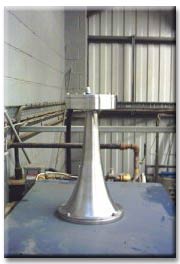
Acoustic cleaning is a maintenance method used in material-handling and storage systems that handle bulk granular or particulate materials, such as grain elevators, to remove the buildup of material on surfaces. An acoustic cleaning apparatus, usually built into the material-handling equipment, works by generating powerful sound waves which shake particulates loose from surfaces, reducing the need for manual cleaning.
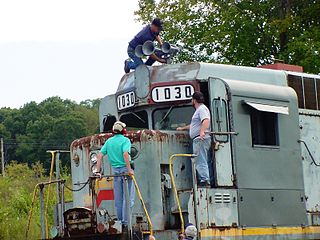
A train horn is an air horn used as an audible warning device on diesel and electric-powered trains. Its primary purpose is to alert persons and animals to an oncoming train, especially when approaching a level crossing. They are often extremely loud, allowing them to be heard from great distances. They are also used for acknowledging signals given by railroad employees, such as during switching operations. For steam locomotives, the equivalent device is a train whistle.

William Rockwell "Rocky" Wirtz was an American businessman. He was the principal owner and chairman of the Chicago Blackhawks of the National Hockey League. He was also president of the Blackhawks' parent company, the Wirtz Corporation, a diversified conglomerate headquartered in Chicago. Under Wirtz's leadership, the Chicago Blackhawks won three Stanley Cups between 2010 and 2015, reversing a period of declining fan interest and on-ice performance. He oversaw Wirtz Corporation's commercial and residential real estate companies, wine and spirits distributor Breakthru Beverage Group, an insurance company, and banks in Illinois and Florida. Wirtz was also half-owner of the Blackhawks' home arena, the United Center, along with Chicago Bulls owner Jerry Reinsdorf. He and Reinsdorf were co-chairmen of the arena's Executive Committee.

Nathan Manufacturing, Inc. is a division of Micro Precision Group which manufactures Airchime, Ltd. train horns mainly for North America. It is one of two major train horn manufacturers in the United States, with Leslie Controls, Inc. being the other.

A vehicle horn is a sound-making device installed on motor vehicles, trains, boats, and other types of vehicles. The horn is activated to warn others of the vehicle's presence or approach, or to call attention to some hazard. Motor vehicles, ships and trains are required by law in some countries to have horns. Trams, trollies, streetcars, and even bicycles are also legally required to have an audible warning device in many areas.

A firefighting apparatus or firefighting appliance describes any vehicle that has been customized for use during firefighting operations. These vehicles are highly customized depending on their needs and the duty they will be performing. These duties can include firefighting and emergency medical services.

